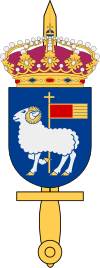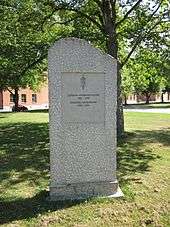Gotland Military District
| Gotland Military District | |
|---|---|
| Gotlands militärdistrikt | |
 | |
| Active | 2000–2004 |
| Country | Sweden |
| Allegiance | Swedish Armed Forces |
| Type | Military district |
| Garrison/HQ | Visby |
| March | "General Wahlgrens marsch" (Sjölin)[1] |
Gotland Military District (Swedish: Gotlands militärdistrikt, MDG) was a Swedish military district within the Swedish Armed Forces active between 2000 and 2004. The staff was located within Gotland Garrison in Visby on Gotland.
History
Gotland Military District was formed on 1 July 2000 and was one of four military districts, which were added in connection with the three military regions was decommissioned on 30 June 2000 as a result of the the 2000 Defense Decision.[2] When the formation of the Gotland Military District occurred, the traditions and heraldic arms of the former Gotland Military Command was taken over.
Gotland Military District was later decommissioned in connection with 2004 Defense Decision. On 17 December 2004 the decommissioning was manifested through a closure and handover ceremony and on 31 December 2004 the district was officially ceased. Its territorial tasks and responsibilities were then transferred from 1 January 2005 to the Central Military District in Strängnäs.[3] Remaining on Gotland was a decommissioning organization until 30 June 2005.
Operations

Gotland Military District consisted of a commanding officer, a staff and a military district group (a total of about 40 employees). The military districts was the regional level in the Swedish Armed Forces' organization and had the following tasks:[4] territorial operations, defense planning, mobilization preparations, intelligence and security service, Home Guard training, voluntary defense activities, physical planning, staff service and operations. This means that the Swedish Armed Forces' contacts with civil authorities and organizations on Gotland largely were handled through the Gotland Military District. Among other things, the military district represented the Swedish Armed Forces in the government pledged assignment on civil-military cooperation, ie the crisis cooperation called "Collaboration on Gotland" (Samverkan på Gotland, GotSam).[4]
Each military district consisted of a number of military districts groups. Within the Gotland Military District was the Home Guard unit called the Gotland Group.[5] I connection of the decommissioning of the Gotland Military District, the territorial responsibility and responsibility of the Gotland Group, was transferred on 1 January 2005 to the Central Military District.[3]
Commaning officers
- 2000–2001 – Major General Curt Westberg
- 2001–2004 – Brigadier General Bengt Jerkland
- 2005–2005 – Colonel Karl Engelbrektson (acting)
References
- ↑ Sandberg, Bo (2007). Försvarets marscher och signaler förr och nu: marscher antagna av svenska militära förband, skolor och staber samt igenkännings-, tjänstgörings- och exercissignaler (in Swedish) (New ed.). Stockholm: Militärmusiksamfundet med Svenskt marscharkiv. p. 201. ISBN 978-91-631-8699-8. LIBRIS 10413065.
- ↑ "Regeringens proposition 1999/2000:30" (in Swedish). Stockholm: Riksdag. 18 November 1999. Retrieved 24 November 2016.
- 1 2 Geschwindt Hartwig, Anna (2004-12-20). "Nedläggnings-ceremoni Gotlands Militärdistrikt" [Closing ceremony Gotland Military District] (in Swedish). Swedish Armed Forces. Archived from the original on 20 February 2007. Retrieved 13 March 2010.
- 1 2 Thalin, Lena (2004-03-03). "Nedläggning av P18 - en konsekvensanalys av de samhälleliga effekterna". LEDNINGSKONTORET, Regionala utvecklingsteamet (in Swedish). Gotlands kommun. p. 9. Retrieved 24 November 2016.
- ↑ "Regeringens proposition 1999/2000:97" (in Swedish). Stockholm: Government of Sweden. 9 March 2000. p. 23. Retrieved 24 November 2016.
External links
- Official website (Archived version)